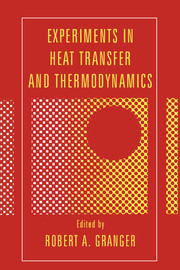Book contents
- Frontmatter
- Contents
- Preface
- Introduction
- Part I Experiments in heat transfer
- I.1 Conduction
- I.2 Convection
- Experiment 7 A forced convection heat-transfer experiment
- Experiment 8 Reynolds analogy for mass transfer
- Experiment 9 Natural-convection melting of a slab of ice
- Experiment 10 Forced-convection heat loss from 3D solids
- Experiment 11 Forced and free convective heat transfer of a laminar flow in a horizontal heated pipe
- Experiment 12 Measurement of convective heat-transfer coefficients on external surfaces
- Experiment 13 Measurement of local heat-transfer coefficient on the ice surface around isothermally cooled cylinders arranged in a line
- Experiment 14 Experiments of unsteady forced convection in ducts with timewise variation of inlet temperature
- Experiment 15 Measurement of heat and mass transfer from a body in air–water mist flow
- Experiment 16 Measurement of transient/steady heat-transfer coefficient with simultaneous photography of flow processes from beneath the heater surface
- I.3 Boiling
- I.4 Mixing, dispersion, and diffusion
- I.5 Radiation
- I.6 Heat pipes and exchangers
- Part II Experiments in thermodynamics
- Appendix 1 Experiments and demonstrations in thermodynamics
- Appendix 2 Experiments and demonstrations in heat transfer
- Appendix 3 Heat-transfer and thermodynamic films
- Index
Experiment 13 - Measurement of local heat-transfer coefficient on the ice surface around isothermally cooled cylinders arranged in a line
Published online by Cambridge University Press: 05 June 2012
- Frontmatter
- Contents
- Preface
- Introduction
- Part I Experiments in heat transfer
- I.1 Conduction
- I.2 Convection
- Experiment 7 A forced convection heat-transfer experiment
- Experiment 8 Reynolds analogy for mass transfer
- Experiment 9 Natural-convection melting of a slab of ice
- Experiment 10 Forced-convection heat loss from 3D solids
- Experiment 11 Forced and free convective heat transfer of a laminar flow in a horizontal heated pipe
- Experiment 12 Measurement of convective heat-transfer coefficients on external surfaces
- Experiment 13 Measurement of local heat-transfer coefficient on the ice surface around isothermally cooled cylinders arranged in a line
- Experiment 14 Experiments of unsteady forced convection in ducts with timewise variation of inlet temperature
- Experiment 15 Measurement of heat and mass transfer from a body in air–water mist flow
- Experiment 16 Measurement of transient/steady heat-transfer coefficient with simultaneous photography of flow processes from beneath the heater surface
- I.3 Boiling
- I.4 Mixing, dispersion, and diffusion
- I.5 Radiation
- I.6 Heat pipes and exchangers
- Part II Experiments in thermodynamics
- Appendix 1 Experiments and demonstrations in thermodynamics
- Appendix 2 Experiments and demonstrations in heat transfer
- Appendix 3 Heat-transfer and thermodynamic films
- Index
Summary
Principle
At the ice–water interface in a steady-state condition, the heat flux transferred from water to the ice–water interface is equal to that conducted from the ice–water interface to ice. By measuring the coordinates of the ice–water interface, the heat flux from the interface to ice is calculated by the boundaryelement method. The local heat-transfer coefficient on the ice–water interface is, then, estimated by Newton's law of cooling.
Object
Ice formation around tubes in a water flow relates to many practical problems such as lowering thermal efficiency or increasing pressure drop in a water-cooled heat exchanger in a refrigeration system. It also relates to many other applications such as the ice-bank method in a low-temperature heatstorage system. In those cases, the local heat-transfer coefficient on the ice surface is an important factor in predicting the ice amount around the tubes and also the thermal efficiency of the heat exchanger. The measurement of the local heat-transfer coefficient, therefore, presents essential information for practical designs.
Apparatus
The experimental apparatus consists of a calming section, a test section, a flow meter, a refrigeration unit, and two circulation systems of water and a coolant as shown in Fig. 13.1. In Fig. 13.2, a schematic illustration of the test section is shown. The test section has a 0.15-m × 0.04-m cross-sectional area and has a 1.0-m length. The walls are made of transparent acrylic resin plates in order to observe the growth of the ice layer, and are installed in the vertical position to minimize the effect of the natural convection of water.
- Type
- Chapter
- Information
- Experiments in Heat Transfer and Thermodynamics , pp. 82 - 87Publisher: Cambridge University PressPrint publication year: 1994



